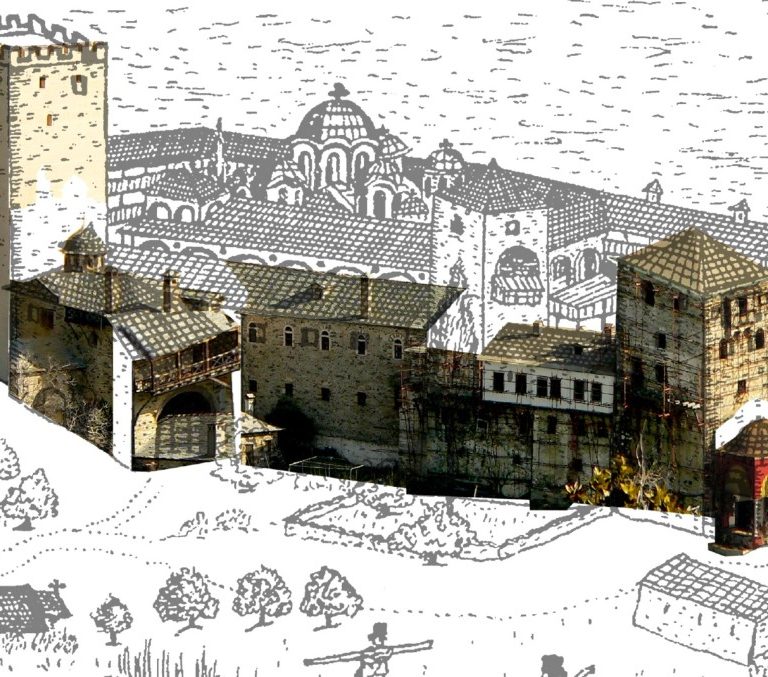Period II (Prior to the Greek Revolution for Independence in 1821)
The confiscation of the Athonite properties by the Sultan Selim II in 1563 forced the monks to borrow large sums of money at exorbitant rates in order to buy them back, and also to pay heavy taxes on them, including a property tax of 14,000 gold fiords (an early form of European gold or silver currency). This situation created economic problems for the Monastery, which tried to overcome them by appealing to people for contributions. Furthermore, the seizure of the large dependency on Limnos in 1581 required the payment of a huge sum to get it back.
However, the Monastery soon managed to recover and even to acquire – either through donations or through their purchase – new buildings and land, such as the Katsori Monastery in Blachia, which was donated in 1629 by the Blachian leader Ioannis Alexandros (Ilias). At the same time, work was started to renovate and extend various buildings at the Monastery, such as the cathedral and the northeastern wing. Thus, when Father Synadinos, a cleric from Serres, visited the Monastery in 1629/30 during a pilgrimage to Agios Oros, he characterized it in his diary as well-kept and tidy.
The period from the mid-17th to the mid-18th century was one of decline. It is likely that the communal life at the Monastery came to an end, with Jeremiah (1648-1656) being the last known abbot. It cannot be ruled out that there were some short-term problems, phenomena which were likely related to the economic difficulties faced by the Monastery. However, a dangerous threat to all the Athonite monasteries was posed by raids by pirates. According to Barsky, the Monastery frequently was attacked by pirates, forcing the monks to fortify their towers with cannons.
With the help of some of its productive dependencies, such as those on Thasos, the Monastery managed to recover during the last decades of the 18th century and to begin a new period of prosperity. This was marked by the acquisition of new dependencies, the development of the older ones, and the completion of large-scale construction at the Monastery: The communal dining room was rebuilt, the central dome of the church and the west wing were repaired, and the north wing was opened, together with the chapel of St Andrew and Ioannikio, and the chapel of the Archangels. Special care was given to the enrichment of the collection of liturgical vessels by the addition of new ones, and also to the commissioning of ornate reliquaries. Despite the fact that all these activities created great debt for the Monastery, the monks managed to deal with this new, difficult economic situation with the help of the well-known nobleman Ioannis Iota Kaytadzoglou of Thessaloniki. During this period, a sizeable number of monks (about 60-136) resided at the Monastery.
However, the Monastery soon managed to recover and even to acquire – either through donations or through their purchase – new buildings and land, such as the Katsori Monastery in Blachia, which was donated in 1629 by the Blachian leader Ioannis Alexandros (Ilias). At the same time, work was started to renovate and extend various buildings at the Monastery, such as the cathedral and the northeastern wing. Thus, when Father Synadinos, a cleric from Serres, visited the Monastery in 1629/30 during a pilgrimage to Agios Oros, he characterized it in his diary as well-kept and tidy.
The period from the mid-17th to the mid-18th century was one of decline. It is likely that the communal life at the Monastery came to an end, with Jeremiah (1648-1656) being the last known abbot. It cannot be ruled out that there were some short-term problems, phenomena which were likely related to the economic difficulties faced by the Monastery. However, a dangerous threat to all the Athonite monasteries was posed by raids by pirates. According to Barsky, the Monastery frequently was attacked by pirates, forcing the monks to fortify their towers with cannons.
With the help of some of its productive dependencies, such as those on Thasos, the Monastery managed to recover during the last decades of the 18th century and to begin a new period of prosperity. This was marked by the acquisition of new dependencies, the development of the older ones, and the completion of large-scale construction at the Monastery: The communal dining room was rebuilt, the central dome of the church and the west wing were repaired, and the north wing was opened, together with the chapel of St Andrew and Ioannikio, and the chapel of the Archangels. Special care was given to the enrichment of the collection of liturgical vessels by the addition of new ones, and also to the commissioning of ornate reliquaries. Despite the fact that all these activities created great debt for the Monastery, the monks managed to deal with this new, difficult economic situation with the help of the well-known nobleman Ioannis Iota Kaytadzoglou of Thessaloniki. During this period, a sizeable number of monks (about 60-136) resided at the Monastery.

